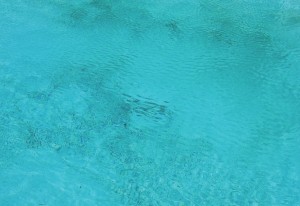Getting the Stains Out
The key is to take action before problems appear
The causes of pool stains are no mystery: organic material, such as algae and tannins from plants, or inorganic material, such as metals, has become attached to the pool surface. Additionally, plaster pools can have grayish staining caused by occluded water (sometimes called hydration staining). But while the causes might be easy to understand, dealing with stains is more challenging. There is a lot of unsubstantiated information on the subject, particularly relating to metal stains and how to treat, remove and prevent them.

Creeping crud: Unsightly stains can be the result of unbalanced pool water. Keep chemicals in check by regularly testing the pool’s pH balance. A low pH balance can eat away at the plaster surface, while a high pH balance will form stains, a result of metals in the water oxidizing. Solution: Add chemical compounds to combat corrosive agents.
All pool water contains metals. Some sources of dissolved metals are familiar: fill water, pool chemicals, deteriorating pool equipment, lawn fertilizers and other chemicals in rain runoff. More recently, the increased use of stone, brick and marble in and around pools has added to the levels of dissolved metals in pool water. This is because of the acidic nature of rainwater, which typically has a pH of 5.0 to 5.6, but sometimes as low as 1.8 in highly populated areas. Acidic rainwater releases the metals found in these materials. Marble, flagstone and granite, for example, naturally contain iron which can leach into a pool.
Balanced pool water is essential. Poor chemistry in any pool, regardless of the water source, can eventually destroy pool equipment and surfaces. By its chemical nature, pure water is very corrosive. This point is especially important for owners of plaster pools to understand because if the water does not contain enough carbonate (alkalinity) or calcium (hardness), it can impact the plaster.
Nor are vinyl pools immune: Severely unbalanced pool water can leach the plasticizer (the chemical added to vinyl to give it flexibility and elasticity) out of vinyl liners.
pH is the most significant factor in preventing and removing stains, and is often overlooked because pool water can look clear even at very high or very low pH levels. Pool water with a low pH can dissolve the metals found in pool equipment and heat exchangers. And just as the stone and brick used around the pool can dissolve in acidic water, so too will the pool’s plaster surface, resulting in more surface pitting and etching and the release of embedded metals into the water. At the other end of the pH spectrum, high levels cause metals to “plate out” of the water, or form stains at the molecular level that discolor pool surfaces.
Pools with high total dissolved solids are especially problematic for controlling stains because the salt content of the water is naturally high. Salt water is corrosive. Additionally, chemical compounds frequently behave differently in high salt solutions. To add to the problem, there is a growing body of evidence suggesting that plaster surfaces may be more soluble in salt water than in fresh water. Salt water pool owners, and those who service them, need to be especially diligent in monitoring water chemistry.

Creeping crud: Unsightly stains can be the result of unbalanced pool water. Keep chemicals in check by regularly testing the pool’s pH balance. A low pH balance can eat away at the plaster surface, while a high pH balance will form stains, a result of metals in the water oxidizing. Solution: Add chemical compounds to combat corrosive agents.
Unbalanced water can facilitate the release of metals and surface staining, but what’s also true is that even pools with balanced water will eventually stain. Since metal levels in pool water are constantly rising, the water eventually becomes saturated. Dissolved metals are then released onto pool surfaces, resulting in stains. In order to minimize metal staining, it is important to determine the concentrations of various metals in the water (or “metal load”), protect the metals from oxidizing on the surface of the pool, and reduce the concentration of the metals in the water.
Metal tests properly conducted with precisely calibrated scientific instruments are very accurate. But common liquid dropper and strip format tests, while convenient and affordable, have limitations. Sequestering agents and other chemicals interfere with these tests, frequently showing metal levels that have tested significantly lower than they actually are. When testing for metals, make certain the kits contain a releasing agent, and are measuring total and not just “free” metal concentrations. In general, two-step metal testing procedures measure total metal concentrations, while one-step procedures measure only free metal concentrations.
Once you know the metal load of the pool water, you need to take action to minimize staining. One effective temporary measure is to add a sequestering agent. These chemical compounds tie up the dissolved metals and prevent them from oxidizing on the pool surface. Unfortunately, sequestering agents do not effectively remove metals from pool water, and they break down over time, losing their ability to bind metals.
Unfortunately, the molecular size of sequestered metals is too small to be effectively filtered under most conditions. Efficient removal of sequestered metals requires highly sophisticated filtration systems. The typical pool filtration system is able to remove only relatively large particles, which means that most, if not all, of the time, sequestered metals pass through the filter and return to the pool.
In studies performed in our chemistry laboratory using filters equivalent to or better than those found in the best pool filtration systems, sequestering agents removed less than 5 percent of dissolved copper from properly balanced water. While somewhat better results were obtained with dissolved iron (ranging from 50 percent to less than 1 percent removal), significant amounts of iron remained in the water. One notable exception was with liquid sequestering agents and plaster dust. These materials tend to stick together to form larger particles. Depending on the size of these particles, they can be removed by many filtration systems. Even under these circumstances, some metals will remain in thewater, often in significant amounts.
Ultimately, to prevent metal staining, the concentration of metal in the pool water must be reduced. This can be accomplished in one of three ways. One option is to dilute the metals by removing some of the existing pool water and replacing with fresh metal-free water. This is often not possible due to either the lack of metal-free water or the cost associated with water replacement. A second option is to use an ion exchange resin system to remove the metals from the water. This process, while relatively straightforward, tends to reduce the calcium concentration of the water, thereby requiring the addition of calcium compounds to restore the proper hardness to the water. A third choice is to use a newly developed insoluble chelating polymer to remove the metals from the water. This material is easy to use, does not impact the hardness of the water, and does not interact with other pool chemicals.
The best way to keep pools free from metal stains is to take a proactive approach rather than waiting for problems to occur. Use fill water relatively free of metals, keep pool water properly balanced, and regularly use effective metal control and eliminating agents.
Laurino, Ph.D. MBA is the founder and president of Periodic Products, located in Fort Lauderdale, Fla., and the inventor of the company’s polymer technology.
This article was written by Joseph P. Laurino and originally appeared on Pool & Spa News [link].
